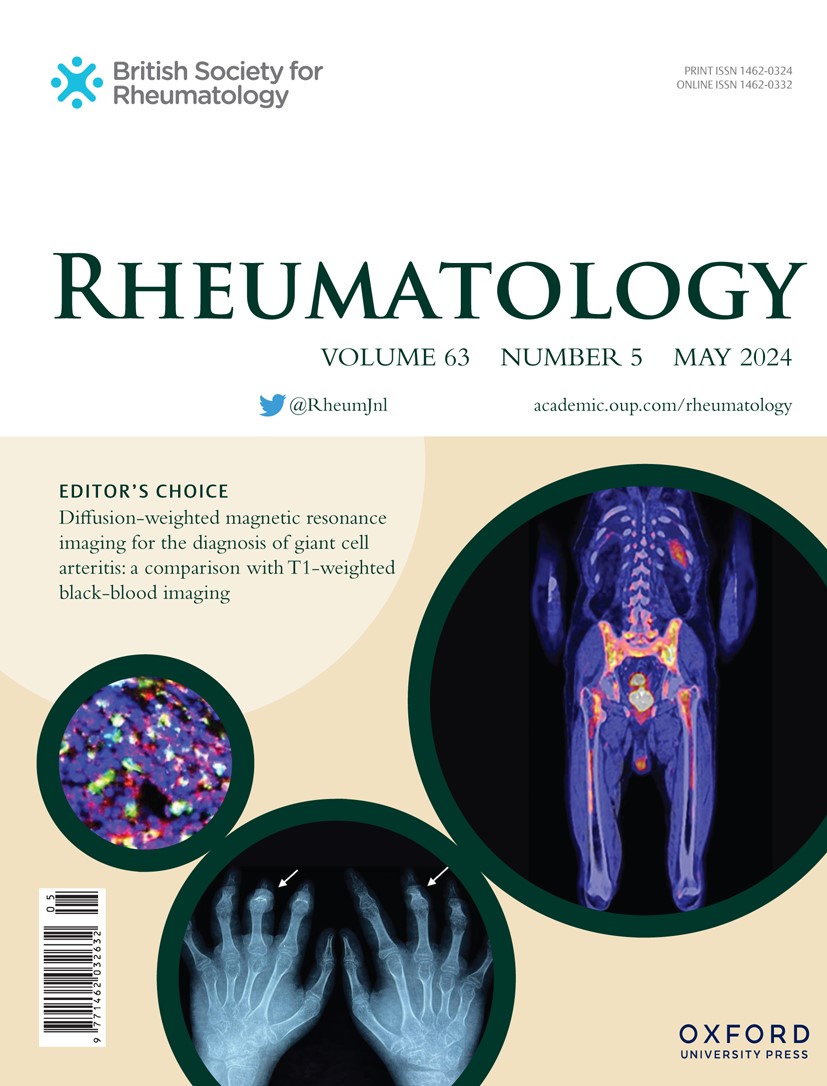Clinical-imaging characteristics and management of anti-JO-1 and non-JO-1 anti-synthetase syndrome-associated interstitial lung disease
IF 4.7
2区 医学
Q1 RHEUMATOLOGY
引用次数: 0
Abstract
Objectives Given a substantial proportion of patients with ASS-ILD (anti-synthetase syndrome-associated interstitial lung disease) develop progressive pulmonary fibrosis (PPF), we aimed to investigate the clinical-radiographic characteristics and treatment in patients with or without anti-Jo-1 antibody. Methods Patients diagnosed with ASS-ILD from two centers were retrospectively reviewed and stratified into subgroups according to the anti-synthetase antibody. Demographic, clinical features, radiographic patterns, pulmonary function tests, management, and mortality were compared. Results In total, 377 patients were recruited, comprising 169 (44.8%) with anti-Jo-1 and 208 (55.2%) without, including 89 (23.6%) with anti-EJ, 72 (19.1%) with anti-PL-7, 39 (10.3%) with anti-PL-12 and 8 (2.1%) with anti-OJ. Patients with non-Jo-1 had significantly longer diagnostic durations (p= 0.037), hyperglobulinemia (p< 0.05), and more frequently combined with secondary Sjögren’s syndrome (p= 0.003) compared with those with anti-Jo-1. Regarding the radiographic patterns, patients with Anti-Jo-1 antibody frequently showed an organizing pneumonia pattern (15.6%) in chest high-resolution computed tomography (HRCT), while non-Jo-1 exhibited the fibrotic radiographic patterns, including usual interstitial pneumonia (UIP) (43.3%) and nonspecific interstitial pneumonia (NSIP) (52.2%). Moreover, patients with anti-Jo-1 had received an increased corticosteroids dose. Despite these, antifibrotic treatments and mortality were comparable between patients with anti-Jo-1 and non-anti-Jo-1. Conclusion Patients with ASS-ILD had distinctive clinical-imaging characteristics among the different antibodies, and non-anti-Jo-1 patients were susceptible to presenting a fibrotic phenotype. Further long-term study is needed to investigate the disease behaviour to guide optimal treatment strategy.抗jo -1和非jo -1抗合成酶综合征相关间质性肺疾病的临床影像学特征和治疗
鉴于相当比例的ASS-ILD(抗合成酶综合征相关间质性肺疾病)患者发展为进行性肺纤维化(PPF),我们旨在探讨有或没有抗jo -1抗体的患者的临床放射学特征和治疗方法。方法回顾性分析两个中心诊断为ASS-ILD的患者,并根据抗合成酶抗体水平进行分组。比较了人口统计学、临床特征、影像学、肺功能检查、管理和死亡率。结果共纳入377例患者,其中抗jo -1 169例(44.8%),无抗208例(55.2%),其中抗ej 89例(23.6%),抗pl -7 72例(19.1%),抗pl -12 39例(10.3%),抗oj 8例(2.1%)。非jo -1患者的诊断时间明显更长(p= 0.037),高球蛋白血症(p<;与抗jo -1患者相比,合并继发性Sjögren综合征的发生率更高(p= 0.003)。在影像学表现上,抗jo -1抗体患者在胸部高分辨率计算机断层扫描(HRCT)上多表现为组织型肺炎(15.6%),而非jo -1患者表现为纤维化型肺炎,包括常规间质性肺炎(UIP)(43.3%)和非特异性间质性肺炎(NSIP)(52.2%)。此外,抗jo -1的患者接受了增加的皮质类固醇剂量。尽管如此,抗纤维化治疗和死亡率在抗jo -1和非抗jo -1患者之间是相当的。结论不同抗体的ASS-ILD患者具有不同的临床影像学特征,非抗jo -1患者易表现为纤维化表型。需要进一步的长期研究来调查疾病行为,以指导最佳的治疗策略。
本文章由计算机程序翻译,如有差异,请以英文原文为准。
求助全文
约1分钟内获得全文
求助全文
来源期刊

Rheumatology
医学-风湿病学
CiteScore
9.40
自引率
7.30%
发文量
1091
审稿时长
2 months
期刊介绍:
Rheumatology strives to support research and discovery by publishing the highest quality original scientific papers with a focus on basic, clinical and translational research. The journal’s subject areas cover a wide range of paediatric and adult rheumatological conditions from an international perspective. It is an official journal of the British Society for Rheumatology, published by Oxford University Press.
Rheumatology publishes original articles, reviews, editorials, guidelines, concise reports, meta-analyses, original case reports, clinical vignettes, letters and matters arising from published material. The journal takes pride in serving the global rheumatology community, with a focus on high societal impact in the form of podcasts, videos and extended social media presence, and utilizing metrics such as Altmetric. Keep up to date by following the journal on Twitter @RheumJnl.
 求助内容:
求助内容: 应助结果提醒方式:
应助结果提醒方式:


